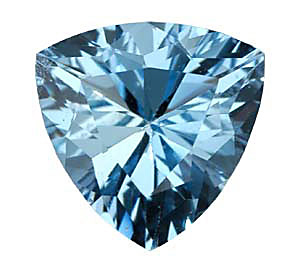The Gemstone Aquamarine

Aquamarine, named for the Latin phrase "water of the sea", is the blue to blue-green variety Beryl. Beryl also contains other gem varieties, including Emerald, and some lesser known varieties such as Morganite and Heliodor. Aquamarine ranges in color from a faint light blue to blue and bluish-green, with lighter colored stones being the more common type. Light green Beryl can be transformed into Aquamarine if heated to 750º F (400º C). The green hues in most Aquamarine can also be removed through heat treatment.
Chemical Formula
?
Be
3Al
2Si
6O
18
Mineral Class
?
Beryl (
Aquamarine)
Additional Properties
|
Refractive Index
?
1.57 - 1.58 |
Double Refraction
?
.006 |
Transparency
?
Transparent to translucent |
SG
?
2.6 - 2.8 |
Luster
?
Vitreous |
| Cleavage ?
3,1 - basal |
All About
Aquamarine is a relatively common gemstone, and is affordable in lighter colors. Deeper colors can command high prices. Some enormous transparent crystal masses of Aquamarine have been found, and exquisite gems weighing thousands of carats have been cut from them.
The light blue to blue-green color of Aquamarine may fade upon prolonged exposure to light, so it is especially important to purchase this gem from a reliable dealer. Aquamarine is a hard and durable gem, but it may develop internal
cracks if banged hard.
Light blue
Topaz is easily mistaken for Aquamarine. The colors of these two gems can be identical, and their physical properties are very similar. Topaz is generally less expensive, and some fraudulent dealers may sell their Topaz as Aquamarine.
Unlike
Emerald, Aquamarine gems are often completely
flawless. Aquamarines with visible flaws are rarely seen. The costs of producing synthetic Aquamarine are very high when compared to the relative abundance of this gem, so synthetic Aquamarine is generally not produced for the gemstone market.
Uses
?
Aquamarine is faceted into many cuts. It is a popular stone for rings, earrings, necklaces, and other jewelry forms. Many exceptionally large and
flawless Aquamarine gem pieces have been cut. Occasionally, perfect, flawless, six-sided crystals are worn as necklace pendants. Translucent Aquamarine displaying
cat's eye effect and
asterism are uncommon, but they do exist and are cut and polished into
cabochons. Lesser quality Aquamarines lacking good transparency are sometimes used as beads and as rough polished stones in bracelets and necklaces.
Aquamarine is the
birthstone of March.
False Names
?
Brazilian Aquamarine - May refer to Aquamarine that originates in Brazil, but often is used as a false name for blue
Topaz.
Mass Aqua - Faceted glass that is dyed blue to resemble
Aquamarine.
Nerchinsk Aquamarine - False name for blue
Topaz.
Siam Aquamarine - False name for
heat treated blue
Zircon.
Treatments & Enhancements
?
Most Aquamarines on the market are
heat treated. Natural Aquamarine is is usually lighter and more greener in color, and heat treatment creates deeper bluer hues. While natural deeper bluish hues do exist, they are uncommon. The gemstone industry considers it an acceptable practice to heat treat Aquamarines, although this information should always be disclosed to the buyer.
Aquamarine Sources
?
Brazil is the largest producer of gem Aquamarine; other important producers are Pakistan, Myanmar (Burma), Russia, China, Namibia, Mozambique, Zambia, Kenya, and the United States (Colorado and California).
Similar Gemstones
?
Blue Topaz is easily confused with Aquamarine. Blue
Zircon is also very similar to Aquamarine, although its color is usually a deeper blue.
Aquamarine in the Rough Photos
?
Aquamarine Jewelry Photos
?